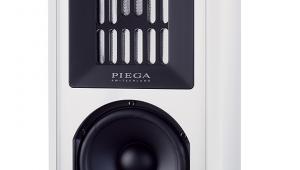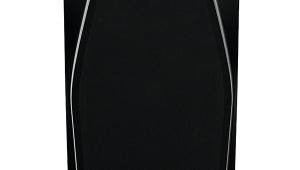Acoustic Energy Ae1 Mkiii Se (£2500)
Has it really been more than 20 years since Acoustic Energy bridged the worlds of professional studio monitoring and domestic audio? Back in ’88, the former regarded the latter in the way that, say, Labour regards fiscal responsibility. AE was having none of it, and produced a classy, compact two-way monitor of true studio merit, sort of a UK answer to Wilson’s WATT.
Given its diminuitive stature, most noteworthy was the AE1’s prodigious bass. Rear-ported and boasting a still-radical metal mid/bass driver, it begged to be positioned away from walls on solid 24in stands. It was, as hindsight allows us to judge, a robust alternative to the LS3/5A for those who equate SPLs and bass extension with absolute merit. But it was also detailed and refined, if far less romantic than its BBC-sanctioned rival. To use the parlance of a headbanger, the AE1 simply rocked – and quickly garnered a cult following.
Marking the original AE1’s anniversary, this constantly evolving speaker is being issued in a strictly limited quantity of 250 numbered pairs, with a range of finishes including ‘bespoke’, just in case you want them to match your Bugatti Veyron. Mere mortals can order hand-finished piano black lacquer or real wood cherry veneer for £2500 per pair, or pearl white and bespoke finishes for £3250.
BELT AND BRACES
Its heavily-braced18mm MDF enclosure measures only 295x180x255mm (HxWxD). Imparting further solidity is an inner lining of 4mm steel plate, applied with a specially manufactured damping glue; AE has always championed stiff, well-damped enclosures, again recalling the era in which they first appeared. For historical perspective, the period was noteworthy for its obsession with speaker enclosure integrity. Solutions to resonance problems included such extremes as the aforementioned WATTs, which were impossibly dense and heavy, with Celestion’s lightweight, Aerolam SL600s at the other end of the design spectrum. The AE1 represented not compromise, but balance.
Finished in silver on the review pair, and complementing perfectly the gloss red enclosure, is a 12mm thick baffle milled from a solid aluminium block. The driver apertures are smoothly curved to prevent any interruptions with the dispersion of the 38mm ring radiator tweeter, said to be good to 40kHz, and the 110mm ‘pure piston’ aluminium cone mid/woofer. The latter uses the company’s trademark spun-alloy cone, with twin neodymium magnets and a 32mm voice coil, mounted in a rigid die-cast magnesium alloy chassis.
Inside the MkIII SE is a completely redesigned crossover, AE having reduced the number of components from thirteen to six. The roster of components attests to the no-compromise nature of this deluxe iteration of the AE1, a mix of ferrite-core and air-core inductors, Welwyn wire-wound resistors and polypropylene film capacitors. All internal wiring is PTFE-coated multi-strand silver cable, with the back bearing a single pair of gold-plated WBT binding posts.
Let nothing suggest that this is a simple two-way you can just whack onto a pair of stands and drive with whatever is to hand. Impedance is rated at 8ohm, but the speaker is ‘1980s hungry’ with a sensitivity rating of only 87dB from 1W [see Lab Report, p67], and it deserves stands that will exploit the benefits of its acoustically dead enclosure. I dug out my treasured Foundation stands, with Blu Tack in-between the base of the speakers and the top of the stands, connected to a range of amps with Yter cable. These included Quad II-eighty and Trilogy 990, which barely made the AE1’s whisper; Krell’s S300i or the McIntosh MC2200 are the minimum I’d recommend. One suspects these mini marvels will handle whatever you care to feed them.
LOOK AT 'EM GO...
Interestingly, every visitor during the listening tests commented on the same phenomenon: the visibly and – for the uninitiated – mildly disconcerting travel of the woofer at even soft levels. As the AE1s are grille-less, you need to learn to live with this, but many would just say that it attests to the unlikelihood of blowing the woofers easily. At no point did I detect any strain, and there was never a hint of the dreaded LS3/5A ‘thwack’ – the LS3/5A’s equivalent of a death rattle.
However much one may approach the latest AE1s for their retro value, performance-wise they have evolved as much as the current Mini has from Sir Alec Issigonis’ 1959 original. Aside from sensitivity considered low by today’s norms, and the delivery of the bass and sound pressure level that made the first AE1 so noteworthy, the new version is devoid of the aggression that – for me – marked the original design.
MEMORY LANE
20 years is a long time, but I have no doubts when recalling the first AE1s that they were too ‘studio-esque’ for my tastes. That cut-glass, in-your-face edginess has all but vanished, while at the same time none of the strengths have been compromised. However impressed I am by the way the latest LS3/5A seems to go a shade louder and deeper than the KEF-driver’d original, there’s an inescapable sensation that they’re not indestructible. Conversely, the AE1 MkIII SE never forgets that many studio denizens are old rockers, so they appear to have the indestructability of a Toyota pick-up truck.
What makes them worth every penny are the deceptively copious bass and imaging to rank with even the blessed Guarneri. The drums panning across the soundstage, on Santana’s ‘Evil Ways’ courtesy of Sundazed’s new 180g pressing, showed the mettle of the AE1: no matter how far apart I positioned them, there was never a ‘hole in the middle’, while the body possessed by the bass begged for a dose of Kodo drummers at full tilt. The sound was rich and deep, like a well-aged Barolo, and this character also applied to voices. With 250 pairs allocated for the whole world, methinks they’ll vanish pretty quickly.
VERDICT
Like its grandpa, the AE1 Mk III SE delivers far more bass and level than any sane person would anticipate from so small a box. An alternative to a less-gainly £2-£3k floorstander, its spectacular imaging and small size are truly seductive. With its lavish finishes and rarity value, it enters another realm as well: that of exclusive watches and collectable pens.
Originally published in the March 2009 issue


























































